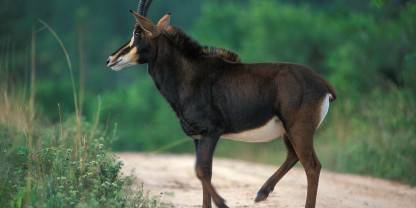- January: Excellent
- February: Excellent
- March: Good
- April: Poor
- May: Poor
- June: Good
- July: Excellent
- August: Excellent
- September: Excellent
- October: Fair
- November: Poor
- December: Good
- Excellent
- Good
- Fair
- Poor
A visit to Shimba Hills National Reserve is usually best in the drier months, from July to September and January to February. Although the reserve can be visited year-round, visits during the rains are more challenging. The vegetation is thicker in the wet months, which makes animal spotting difficult, and the abundance of water means wildlife tends to be more dispersed.
Shimba Hills Safaris
-
Best Time
- July to September and January to February (Best wildlife viewing; little rainfall)
-
High Season
- December to March and July to October (The park never gets very busy)
-
Low Season
- April to June (Low-season rates may apply)
-
Best Weather
- July to September and January to February (Little rainfall)
-
Worst Weather
- April, May and November (Wettest months)
December to March & June to September Drier Seasons
- Mostly sunny without much rain
- Animals are easier to spot because they gather around water and the grass is shorter
- The reserve never gets very busy
- Coastal resort hotels, which can be used as a base, get very busy
- Scenery is drier and haze in the sky detracts from the views
April to May & October to November Wet Seasons
- Everything is green and lush, with many flowers
- There are very few other visitors
- Bird watching is excellent
- Days can be overcast, and rain can interfere with your activities
- Animals are dispersed and the vegetation is thicker, making them difficult to spot
Wildlife Photos
Best Time To Go by Major Park
- Excellent
- Good
- Fair
- Poor
-
Amboseli National Park
- January: Excellent
- February: Excellent
- March: Good
- April: Fair
- May: Fair
- June: Excellent
- July: Excellent
- August: Excellent
- September: Excellent
- October: Excellent
- November: Fair
- December: Good
-
Buffalo Springs NR
- January: Excellent
- February: Excellent
- March: Good
- April: Fair
- May: Fair
- June: Excellent
- July: Excellent
- August: Excellent
- September: Excellent
- October: Good
- November: Fair
- December: Good
-
Lake Nakuru National Park
- January: Excellent
- February: Excellent
- March: Good
- April: Fair
- May: Fair
- June: Excellent
- July: Excellent
- August: Excellent
- September: Excellent
- October: Excellent
- November: Excellent
- December: Excellent
-
Masai Mara NR
- January: Good
- February: Good
- March: Fair
- April: Fair
- May: Good
- June: Excellent
- July: Excellent
- August: Excellent
- September: Excellent
- October: Excellent
- November: Fair
- December: Fair
-
Samburu National Reserve
- January: Excellent
- February: Excellent
- March: Good
- April: Fair
- May: Fair
- June: Excellent
- July: Excellent
- August: Excellent
- September: Excellent
- October: Good
- November: Fair
- December: Good
-
Tsavo East National Park
- January: Excellent
- February: Excellent
- March: Good
- April: Fair
- May: Fair
- June: Excellent
- July: Excellent
- August: Excellent
- September: Excellent
- October: Excellent
- November: Fair
- December: Good
-
Tsavo West National Park
- January: Excellent
- February: Excellent
- March: Good
- April: Fair
- May: Fair
- June: Excellent
- July: Excellent
- August: Excellent
- September: Excellent
- October: Excellent
- November: Fair
- December: Good



